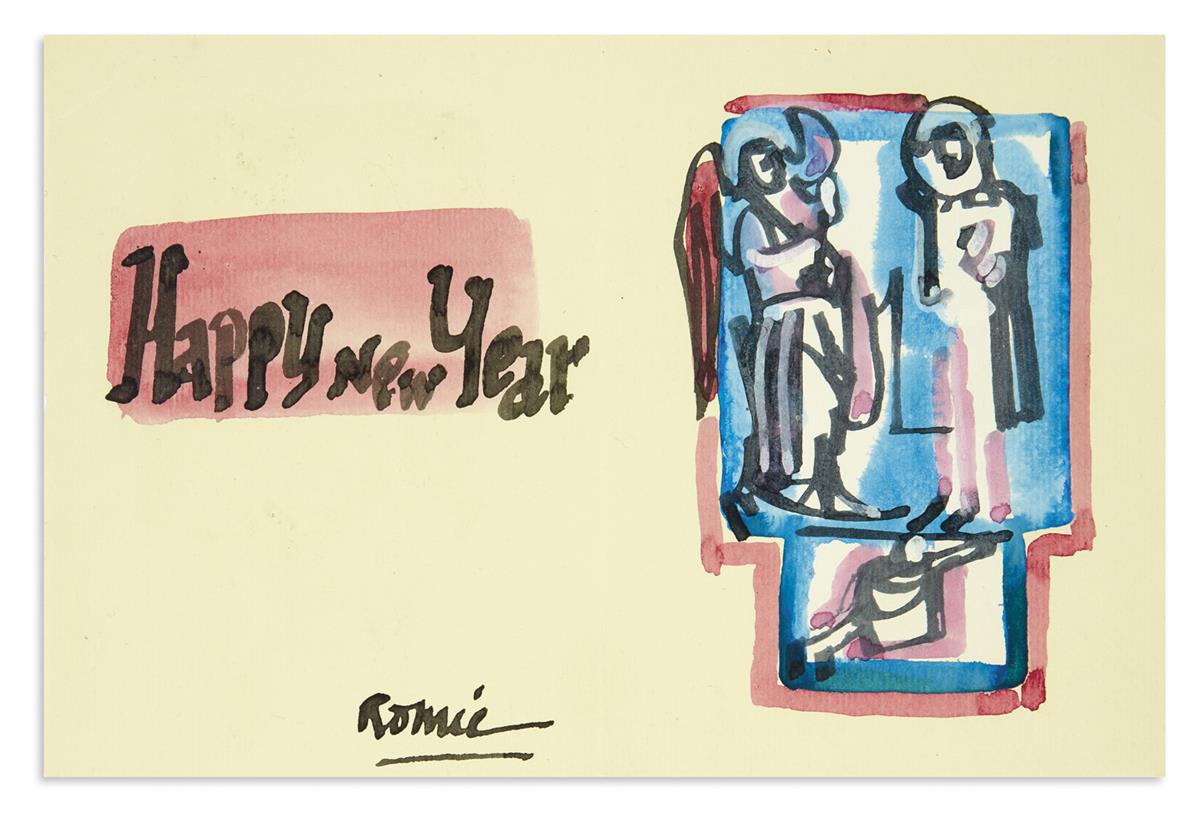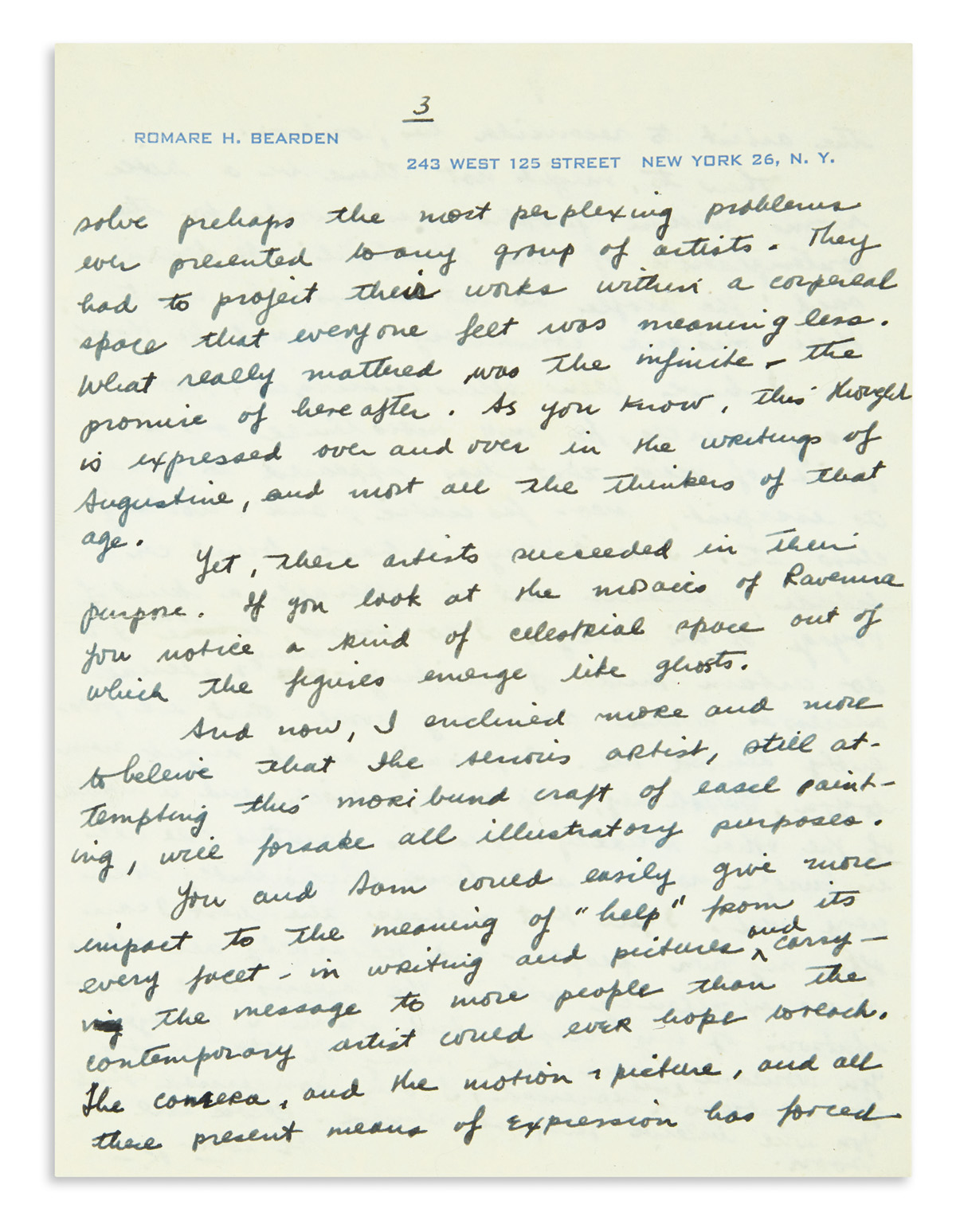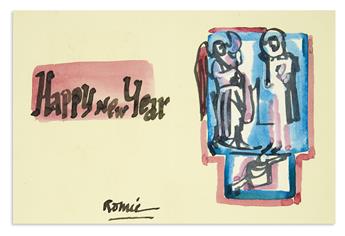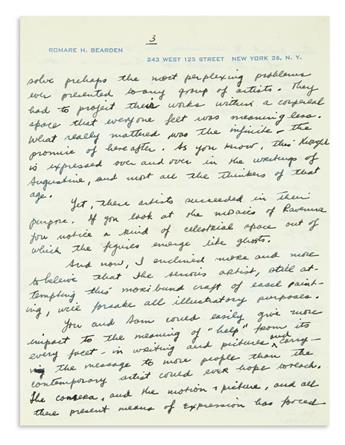Sale 2534 - Lot 103
Price Realized: $ 3,800
Price Realized: $ 4,750
?Final Price Realized includes Buyer’s Premium added to Hammer Price
Estimate: $ 5,000 - $ 7,500
" I LIKE TO THINK NOW OF PAINTING . . . AS A KIND OF SILENT MUSIC" (ART.) Archive of letters, postcards, and greeting cards sent by the artist Romare Bearden. 21 items in one folder: 5 Autograph Letters Signed as "R" or "RB"; 6 postcards from Bearden and his wife Nanette to Harry Henderson; watercolor greeting card featuring original art; 4 signed printed greeting cards, some featuring Bearden's work; and 5 exhibit catalogues; condition generally strong. Vp, 1949-87 and undated
Additional Details
The artist Romare Bearden (1911-1988) wrote these letters to his longtime friend and collaborator Harry Henderson (1915-2003), an editor and journalist from Croton-on-Hudson, NY. The two were joint authors of two important books, 'Six Black Masters of American Art' (1972) and 'A History of African American Artists,' completed after Bearden's death in 1993.
The earliest letter, postmarked 25 October 1949, offers insight into Bearden's artistic vision and the life of a struggling young artist: "I've risen to the estate now where I have a telephone . . . call before the company takes it away from me. . . . The great power of the painter lies in his ability to show and not depict. . . . The serious artist, still attempting this moribund craft of easel painting, will forsake all illustratory purposes. . . . The camera and the motion picture, and all these present means of expression has forced the artist to reconsider his position. Then, too, might not there be a little room within peoples' frameworks for the contemplation of the beautiful? As Lenin said, 'the people do not necessarily want their miseries constantly mirrored for them.' I have often been criticized from many sources for my insistence on a point of view that has appeared to some as escapist, neo-fascistic, anti-working class, etc. I can't say I have found certitude, because it is after all a kind of voyage of discovery. I do know, were I to do certain kinds of painting, many material successes would come my way that are presently denied me. . . . I feel that perhaps the best I can offer my own people, and naturally all others, is an excellency within the means and limitations of my craft."
His 21 November 1955 letter discusses popular reaction to his work: "There are not too many people who are grasping what I'm after in this exhibition of painting. Especially the collectors who formerly bought my work. . . . I've tried in these latest works to incorporate some of the principles of the masters that must be present in all works. . . . I look with unending delight at the paintings of Titian, Velasquez, and Rembrandt, but where their pictures were involved and made cohesive in a hundred different ways, I might be able to use only three or four. . . . I want to compose with color and give it its own head, like one must do with a fine dog on the track of something. . . . Color if used successfully is a force, a position, and among other things an element. You start off with your blank paper, or canvas, and you place an orange, or a blue, and something happens. The orange will want to be heard from again, and the blue will be there like a shrill note that wants for immediate orchestration. . . . I like to think now of painting, my painting that is, as a kind of silent music."
The later letters, from the period of their research collaboration, are shorter and more direct, but contain interesting thoughts on Bearden's contemporaries. In 1973 he wrote "Cortor has become a little flaky and seems to have dissipated all his talent." In a mostly typed 1982 aerogramme from St. Maarten, he wrote "I'm glad Mayhew has come round, and that he also [got] tenure. That's why he had to leave Hunter College." A 1987 letter reflects on art history: "The Impressionists & later the Cubists had to look elsewhere, to the Japanese print, the African sculptures. As Wm Black wrote, there is more wisdom in the tigers of wrath than in the houses of instruction."
The hand-painted greeting card, 6 1/2 x 10 inches when open, reads simply "Happy New Year, Romie" and features a medieval-inspired watercolor in red, blue and black. The 5 exhibit catalogues are dated 1977 to 1984; each is signed and inscribed by Bearden to the Hendersons. Taken as a whole, this archive offers rare insight into the vision of an important American artist.
The earliest letter, postmarked 25 October 1949, offers insight into Bearden's artistic vision and the life of a struggling young artist: "I've risen to the estate now where I have a telephone . . . call before the company takes it away from me. . . . The great power of the painter lies in his ability to show and not depict. . . . The serious artist, still attempting this moribund craft of easel painting, will forsake all illustratory purposes. . . . The camera and the motion picture, and all these present means of expression has forced the artist to reconsider his position. Then, too, might not there be a little room within peoples' frameworks for the contemplation of the beautiful? As Lenin said, 'the people do not necessarily want their miseries constantly mirrored for them.' I have often been criticized from many sources for my insistence on a point of view that has appeared to some as escapist, neo-fascistic, anti-working class, etc. I can't say I have found certitude, because it is after all a kind of voyage of discovery. I do know, were I to do certain kinds of painting, many material successes would come my way that are presently denied me. . . . I feel that perhaps the best I can offer my own people, and naturally all others, is an excellency within the means and limitations of my craft."
His 21 November 1955 letter discusses popular reaction to his work: "There are not too many people who are grasping what I'm after in this exhibition of painting. Especially the collectors who formerly bought my work. . . . I've tried in these latest works to incorporate some of the principles of the masters that must be present in all works. . . . I look with unending delight at the paintings of Titian, Velasquez, and Rembrandt, but where their pictures were involved and made cohesive in a hundred different ways, I might be able to use only three or four. . . . I want to compose with color and give it its own head, like one must do with a fine dog on the track of something. . . . Color if used successfully is a force, a position, and among other things an element. You start off with your blank paper, or canvas, and you place an orange, or a blue, and something happens. The orange will want to be heard from again, and the blue will be there like a shrill note that wants for immediate orchestration. . . . I like to think now of painting, my painting that is, as a kind of silent music."
The later letters, from the period of their research collaboration, are shorter and more direct, but contain interesting thoughts on Bearden's contemporaries. In 1973 he wrote "Cortor has become a little flaky and seems to have dissipated all his talent." In a mostly typed 1982 aerogramme from St. Maarten, he wrote "I'm glad Mayhew has come round, and that he also [got] tenure. That's why he had to leave Hunter College." A 1987 letter reflects on art history: "The Impressionists & later the Cubists had to look elsewhere, to the Japanese print, the African sculptures. As Wm Black wrote, there is more wisdom in the tigers of wrath than in the houses of instruction."
The hand-painted greeting card, 6 1/2 x 10 inches when open, reads simply "Happy New Year, Romie" and features a medieval-inspired watercolor in red, blue and black. The 5 exhibit catalogues are dated 1977 to 1984; each is signed and inscribed by Bearden to the Hendersons. Taken as a whole, this archive offers rare insight into the vision of an important American artist.
Exhibition Hours
Exhibition Hours
Aliquam vulputate ornare congue. Vestibulum maximus, libero in placerat faucibus, risus nisl molestie massa, ut maximus metus lectus vel lorem.






